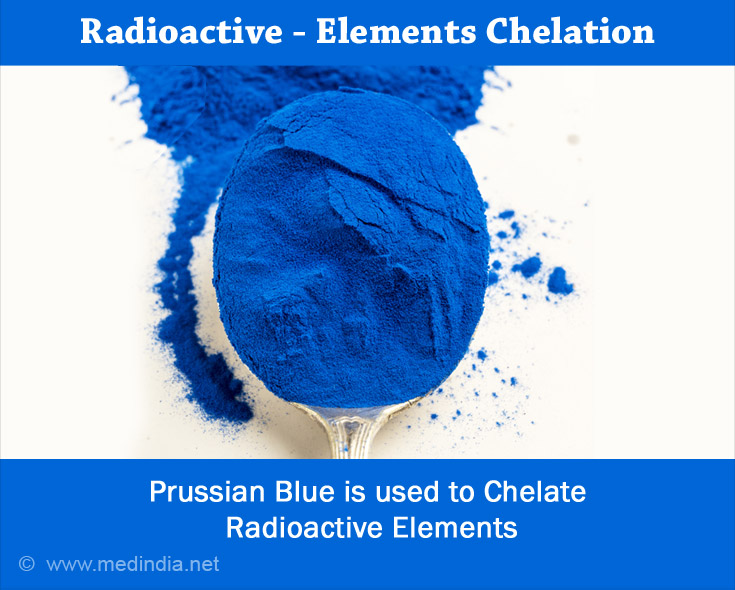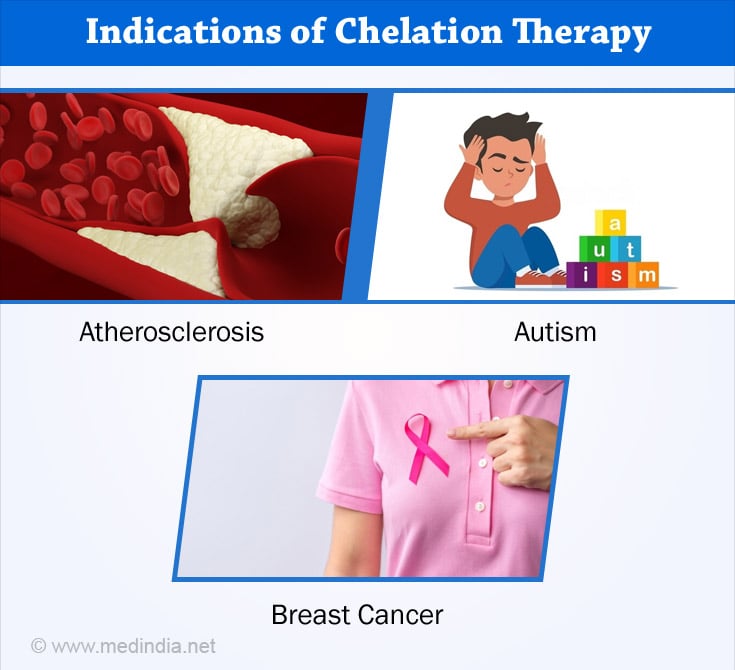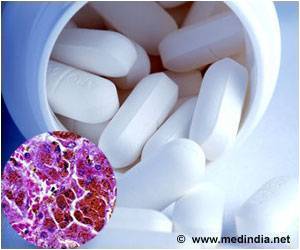- Chelation in metal intoxication - (https://www.ncbi.nlm.nih.gov/pmc/articles/PMC2922724/)
- Chelating Agents - (https://pubmed.ncbi.nlm.nih.gov/31643849/)
- Dimercaprol - (https://www.ncbi.nlm.nih.gov/books/NBK549804/)
- Ethylenediaminetetraacetic Acid (EDTA) - (https://www.ncbi.nlm.nih.gov/books/NBK565883/ )
- Fulvic acid-like substance-Ca(II) complexes improved the utilization of calcium in rice: Chelating and absorption mechanism - (https://www.sciencedirect.com/science/article/pii/S0147651322003426)
- Dimercaptosuccinic acid (DMSA), a non-toxic, water-soluble treatment for heavy metal toxicity - (https://pubmed.ncbi.nlm.nih.gov/9630737/)
- Chelation therapy in intoxications with mercury, lead and copper - (https://pubmed.ncbi.nlm.nih.gov/24894443/)
- Iron Overload and Breast Cancer: Iron Chelation as a Potential Therapeutic Approach - (https://www.ncbi.nlm.nih.gov/pmc/articles/PMC9317809/)
- Chelation therapy for atherosclerotic cardiovascular disease - (https://www.ncbi.nlm.nih.gov/pmc/articles/PMC7198985/)
- Iron chelators in cancer therapy - (https://pubmed.ncbi.nlm.nih.gov/32757166/)
- Iron chelation therapy - (https://pubmed.ncbi.nlm.nih.gov/9350180/)
- EDTA-infusion affect calcium homeostatis leading to increased resistance to challenge? - (https://pubmed.ncbi.nlm.nih.gov/14621393/)
About
Chelation therapy is the process where a drug is used to eliminate a heavy metal from the body and thereby prevent its adverse effect.
Chelation therapy is a type of detox treatment designed to flush out harmful heavy metals such as lead, mercury, and arsenic. These are unwanted by the body and can accumulate and cause toxic effects. Children are particularly vulnerable to the effects of these metals, which may cause permanent damage in them(1✔ ✔Trusted Source
Chelation in metal intoxication
Go to source).
The exposure to heavy metals may be a one-time exposure to a large amount, or may occur over a long period of time. The exposure is usually seen in the work environment. People working in mines or factories using these metals can suffer from toxicity due to the accumulation of the metal over a prolonged period. Food and water often contain small quantities of metals, which if taken over prolonged durations can cause problems. We have recently seen a popular brand of noodles going off the shelves in India due to concerns over its lead content. Some local medications may also contain high quantities of these metals.
Acute or chronic toxicity due to a heavy metal is treated with a chelating drug. The chelating drug binds to the metal and is eliminated along with it in the feces or urine. Exposure to a radioactive substance is also treated with a chelating agent. Several chelating drugs are available in the market(2✔ ✔Trusted Source
Chelating Agents
Go to source).
Chelation Therapy for Heavy Metal Poisoning
Chelators, also known as chelating agents, are injected during chelation therapy. Chelating products are not approved for home use. Ethylenediaminetetraacetic acid (EDTA), dimercaptosuccinic acid, and dimercaprol are some common chelation therapy drugs.
- Dimercaprol / BAL (British Anti-Lewisite) and its analogues: Dimercaprol is effective in poisoning due to the heavy metals such as arsenic, mercury, and lead since it increases the urinary excretion of these metals. It is administered as an intramuscular injection. However, while removing arsenic and cadmium from the body, it may increase their levels in the brain,thus causing unwanted effects. Its analogues, DMSA and DMPS can be given orally(3✔ ✔Trusted Source
Dimercaprol
Go to source). - CaNa2EDTA (Calcium disodium ethylenediamine tetraacetic acid): The calcium disodium salt of EDTA is used as chelation therapy to treat lead poisoning(4✔ ✔Trusted Source
Ethylenediaminetetraacetic Acid (EDTA)
Go to source). When the lead comes in contact with the CaNa2EDTA, an exchange between the calcium and lead takes place. Thus, the lead forms a complex with sodium EDTA, leaving behind calcium in the body. EDTA by itself can cause low calcium levels in the body and therefore is not preferred in comparison to its calcium sodium salt. CaNa2EDTA is also used in manganese and zinc poisoning. Chelation therapy involves weekly intravenous (IV) treatments of ethylenediaminetetraacetic acid (EDTA), which lasts about 30 minutes. - Nitrilotriacetic Acid (NTA): NTA is used as two salts, sodium derivative (Na3NTA) and iron derivative (FeNTA). Its uses are similar to EDTA.
- Fulvic Acid: Fulvic acid is the most powerful natural chelating agent. It results from the decomposition of organic matter into humus, which is microbially processed into humic acids, microbe's further process the humic acids to produce fulvic acid. it can be administered half hour before eating or two hours after eating to improve its detoxing abilities. Take fulvic two hours after or before the medication, if you are taking other medications(5✔ ✔Trusted Source
Fulvic acid-like substance-Ca(II) complexes improved the utilization of calcium in rice: Chelating and absorption mechanism
Go to source). - Dimercaptosuccinic Acid: Oral Chelation is a safe, non-surgical, non-medical treatment used to remove toxic heavy metals and excess calcium and cholesterol. 2, 3 Dimercaptosuccinic Acid (DMSA, Succimer) is an example of a oral chelating agent(6✔ ✔Trusted Source
Dimercaptosuccinic acid (DMSA), a non-toxic, water-soluble treatment for heavy metal toxicity
Go to source).
Radioactive-Elements Chelation
- CaNa3DTPA or ZnNa3DTPA (Calcium or zinc trisodium diethylenetriaminepentaacetate): This chelating agent has been used in poisoning due to exposure to radioactive substances like plutonium, californium, americium, and curium. It is administered as an intramuscular or intravenous injection or via nebulization.
- Prussian blue: It is used to chelate radioactive cesium and thallium. It is given orally. It binds with these substances and brings about their elimination through the feces.

Copper-Chelation Therapy
Unlike the heavy metals like lead, mercury and cadmium, copper is essential for the function of various enzymes in the body. However, excessive copper is toxic. This is often noted in patients with a condition called Wilson's disease. These patients lack an enzyme, which results in accumulation of copper within cells and may lead to organ damage. Drugs used for chelation of copper include:
- D-Penicillamine (DPA): Besides copper, D-Penicillamine can also chelate lead and mercury. It is also effective in patients with severe rheumatoid arthritis. It can be given orally or intravenously(7✔ ✔Trusted Source
Chelation therapy in intoxications with mercury, lead and copper
Go to source). - TETA (Tetraethylenetetraamine or trientine): TETA is another drug used for copper poisoning.
Iron-Chelation Therapy
Like copper, iron is also very important for blood formation and several other body processes. Some people have a high amount of iron which can be toxic to the cells. For example, patients with blood disorders like thalassemia receive repeated blood transfusions and have excess amounts of iron in the body. Iron-chelation therapy is used in these patients to eliminate the excess iron in the urine. Iron chelation has shown to be an effective alternative treatment for breast cancer(8✔ ✔Trusted Source
Iron Overload and Breast Cancer: Iron Chelation as a Potential Therapeutic Approach
Go to source). Common drugs used for iron chelation therapy include:
- Deferoxamine: It is given by intravenous or intramuscular injection. It is also used to chelate aluminum in patients with renal failure. It is commonly used in thalassemia
- Deferasirox and deferiprone: Deferasirox and deferiprone are oral alternatives to deferoxamine.
Chelation Therapy Benefits
Chelation therapy reduces concentration of heavy metals in the body by binding to them and facilitating their elimination. Thus, they are beneficial in patients with heavy metal poisoning, and iron and copper overload. There are other suggested but not proven uses of chelation therapy:
- Chelation Therapy for Atherosclerosis: Chelation therapy is promoted and practiced around the world as a form of alternative medicine in the treatment of atherosclerotic cardiovascular disease. It has been suggested as a safe, relatively inexpensive, non‐surgical method of restoring blood flow in atherosclerotic vessels. There are several suggestions that EDTA may probably remove the calcium from atherosclerotic thickenings in blood vessels and thereby, improve blood flow. However, currently, there isn’t enough evidence to establish the same(9✔ ✔Trusted Source
Chelation therapy for atherosclerotic cardiovascular disease
Go to source). - Chelation Therapy for Autism: It has been suggested that chelation therapy may work in autism patients by removing toxic substances from the body. However, these claims have no basis and the FDA has warned against using this treatment for autism.
- Chelation Therapy for Cancer: Chelation therapy uses injections and dietary supplements to safely and effectively remove these carcinogens from the body(10✔ ✔Trusted Source
Iron chelators in cancer therapy
Go to source).

Chelation Therapy Side Effects
Chelation therapy is not without side effects. Listed below are only some of the side effects of chelation therapy:
- Gastrointestinal symptoms like nausea, vomiting and diarrhea, and skin reactions are commonly noted with chelation therapy. Some of these drugs can also cause kidney or liver damage, or blood abnormalities(11✔ ✔Trusted Source
Iron chelation therapy
Go to source). - Some chelating agents like EDTA may eliminate important metals like zinc and manganese from the body along with the toxic metals. This can result in their deficiency. These metals have to therefore be replaced before and after treatment with these chelating agents. Since zinc is essential during pregnancy, these drugs should not be given to pregnant tients.
- EDTA can also reduce calcium levels in the body, which could cause cardiac complications and require emergency treatment(12✔ ✔Trusted Source
EDTA-infusion affect calcium homeostatis leading to increased resistance to challenge?
Go to source). - Dimercaprol is associated with several side effects including high blood pressure, increased heart rate, pain at the site of the injection, and increased chances of bleeding. Its analogues DMSA and DMPS are better tolerated(3✔ ✔Trusted Source
Dimercaprol
Go to source). - D-penicillamine can predispose to autoimmune conditions. It should also not be given in patients allergic to penicillin since it is obtained from penicillin.
Health Tips
- The chelating agents along with the heavy metals are usually eliminated via the urine. Therefore, the patient should drink plenty of water to facilitate this elimination and prevent toxic effects of the complex on the kidney.
- Some chelating agents are excreted in the feces. Chronic constipation can slow down the elimination, hence regular bowel movements should be ensured.
- Chelating agents are associated with side effects. Keep your doctor informed if you are suffering from any side effects.
- Avoid exposure to heavy metals whenever possible, so that you do not need chelation therapy. Protect yourself well in unavoidable situations.
- Get your drinking water tested for metal content. A reverse-osmosis filter may be useful in places with high metal content.
- Eat packaged food that is certified by your local food safety authorities. Be cautious when consuming local medicines to make sure they do not contain heavy metals.













